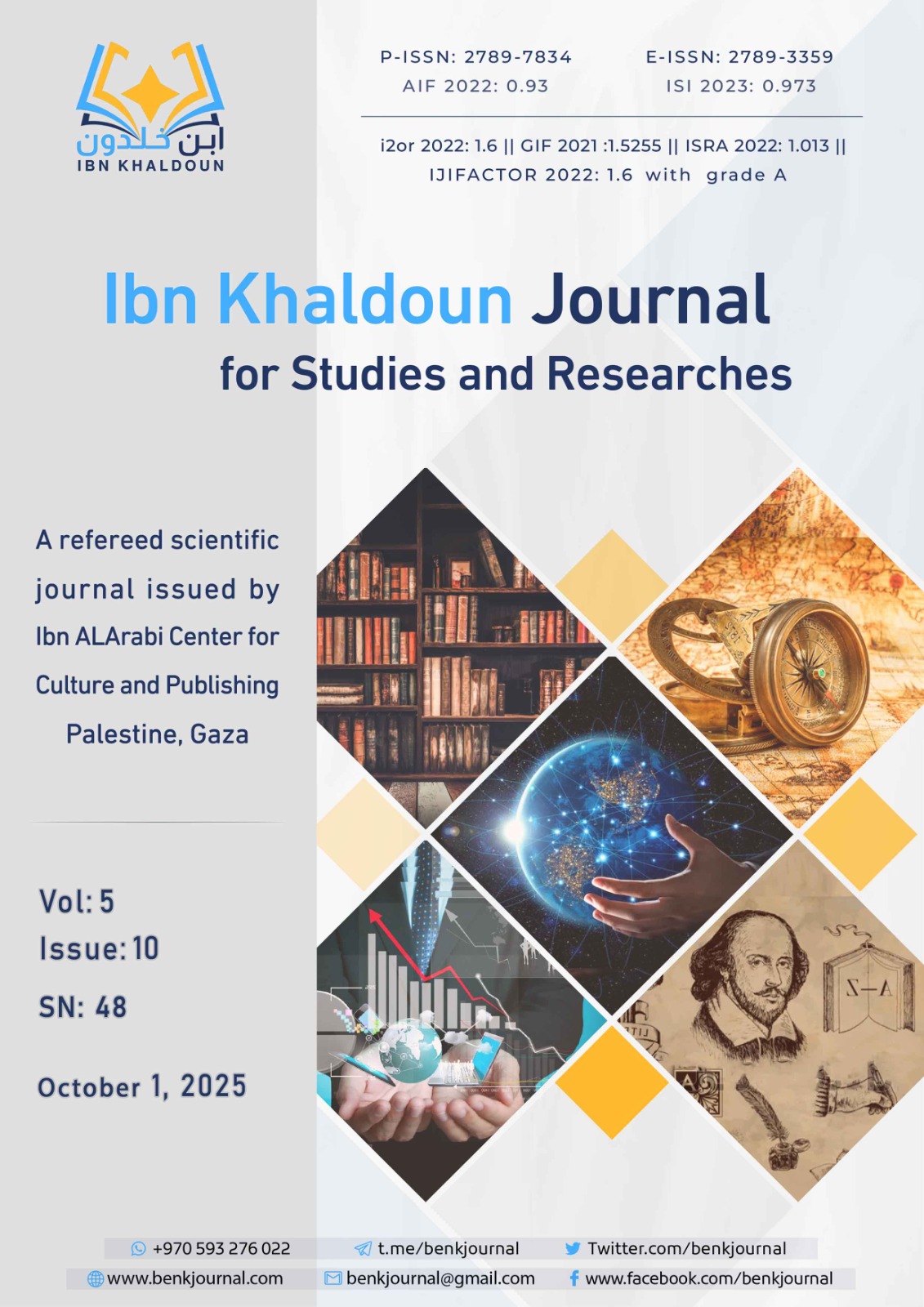Estimating Item Bank Parameters Using the Two-Parameter and Three-Parameter Item Response Models: A Comparative Study
Main Article Content
Abstract
This study aimed to compare the two-parameter and three-parameter item response models in estimating both person ability parameters and item characteristics. A simulated sample, generated to approximate a real dataset using the Wengen3 program, consisted of 3,000 responses, with 1,000 responses generated for each test form. The research instrument was an item bank comprising three equivalent test forms (A, B, and C), each containing 44 items. The Bilog-MG3 program was used to assess data fit to the one-parameter and two-parameter models, and to estimate person and item parameters, the test information function, and empirical reliability. The SPSS program was employed to verify the assumptions of item response theory and to analyze differences between the two-parameter and three-parameter models in estimating person and item parameters, as well as the standard error of ability estimation.
The main findings indicated no statistically significant differences in the generated sample data attributable to the type of model (two-parameter vs. three-parameter) in estimating person ability, item discrimination, or item difficulty. However, statistically significant differences were found in the standard error of ability estimation, favoring the two-parameter model.
Article Details

This work is licensed under a Creative Commons Attribution-NonCommercial 4.0 International License.
References
- إبراهيم، السيد وآخرون (2009): مقارنة بين النماذج اللوغاريتمية لنظرية الاستجابة للمفردة من حيث ملاءمتها للبيانات، مجلة البحث العلمي في التربية، العدد (10).
- حامد، شيرين (2008): أثر نموذج الاستجابة للفقرة وتعدد الأبعاد وطريقة المطابقة في تقدير معالم الأفراد والفقرات، أطروحة دكتوراه غير منشورة، الأردن: جامعة عمان العربية.
- الخليلي، خليل (2012): أساسيات البحث العلمي التربوي. ط1، دبي: دار القلم.
- الدرابسة، رياض (2012): أثر طريقة القدرة وطريقة التعامل مع القيم المفقودة على دقة تقدير معالم الفقرات والأفراد، أطروحة دكتوراه غير منشورة، عمَّان: جامعة اليرموك.
- الزاملي، علي (2015): تأثير نماذج الاستجابة للمفردة على دقة تقديرات القدرة للأفراد باستخدام اختبار المصفوفات المتتابعة لرافن، لارك للفلسفة واللسانيات والعلوم الاجتماعية، ع 8.
- الشافعي، محمد (2011): تأثير نماذج التحليل اللوغاريتمية الأحادية والثنائية والثلاثي البارامتر على تقديرات دوال معلومات المفردات الاختبارية وعلاقتها بدقة تقديرات القدرة: دراسة مقارنة، المجلة المصرية للدراسات النفسية، مج 21، ع73.
- الشافعي، محمد (2014): تأثير انتهاك بعض افتراضات نظرية الاستجابة للمفردة على تدريج بنك الأسئلة ودقة معادلة درجات الاختبارات البنكية المسحوبة ـ مجلة كلية التربية (جامعة بنها)، القاهرة: مج 25، ع 98، 437-440.
- صالح، نوال (2020): أثر اختيار نموذج الاستجابة للمفردة في دقة تقدير معالم المفردة ثنائية الاستجابة، لارك للفلسفة واللسانيات والعلوم الاجتماعية، مج38، عدد38.
- طيفور، مصطفى (2007): دراسة مقارنة لنماذج نظرية الاستجابة للمفردة في معادلة درجات الاختبار، أطروحة دكتوراه غير منشورة، جامعة القاهرة.
- العبد الله، زياد (2012): أثر بعض طرق التقدير على دقة تقدير المعالم ضمن نماذج الاستجابة للمفردة متعددة التدريج، أطروحة دكتوراه غير منشورة: معهد الدراسات التربوية، جامعة القاهرة.
- عطا، زايد (2013): تقصي دقة تقدير النموذج اللوجستي ثلاثي المعلمة لمعالم الفقرة وقدر الأفراد في ضوء تغير طول الاختبار وحجم العينة: دراسة محاكاة، مجلة جامعة الشارقة، مج 11، ع2.
- علام، صلاح الدين (2005): نماذج الاستجابة للمفردة الاختبارية أحادية البعد ومتعددة الأبعاد وتطبيقاتها في القياس النفسي والتربوي، القاهرة: دار الفكر العربي.
- محمد، شحته (2016): الدقة الإحصائية لتقدير بارامترات النماذج الرياضية للاستجابة للمفردة، مجلة رسالة التربية وعلم النفس، ع52.
- محمود، سومية (2012): استخدام نموذج راش في بناء بنك أسئلة لقياس التحصيل في مقرر سيكولوجية التعلم لدى طلاب كلية التربية بالمنيا، أطروحة دكتوراه منشورة، القاهرة: جامعة المنيا، كلية التربية.
- نصراوين، معين (2018): دقة تقدير معالم الفقرات عند استخدام أربعة نماذج لوجستية في إطار نظرية الاستجابة للفقرة، مجلة دراسات العلوم التربوية، مج45، ع4.
ثانيًا: المراجع الأجنبية:
- Baker, F. (2001). The Basics of Item Response Theory Eric clearing house on Assessment and Evaluation.
- Crocker, L. & Algina, J. (1986). Introduction to classical and modern test theory. New York: Holt, Rinehart, 83(3), 154-159.
- Davier, A., Holland, P., & Thayer, D. (2004). The Kernel method of test equating y. New York: Springer.
- Embertson, S. E. & Reise, S. P. (2000). Item Response Theory for Psychologiste. New Jjersey: Lawrence Erlbaum Associates, Publisher.
- Hambleton, R. & Swaminathan, H. (1985). Item response theory: Principles and applications. Boston: Kluwer.
- Hambleton, R., Swaminathan, H., and Rogers, H. (1991). Fundamentals of item response Theory. International Educational and Professional. Sage publication, Inc Newbury park, USA.
- Keller, L. & Keller, R. (2011). The Long – term Sustainability of different item response theory Scaling methods Educational and Psychological Measurement, 7/ (2), 362-379.
- Klein, P. (1993). The handbook of psychological testing, First Published, London, Rouledge.
- Kolen, M. & Brennan, R. (2014). Test equating Scaling and Linking (3rd ed). New York: Springer.
- Lord, F. (1980). Applications of item response theory to practical testing problems. Hillsdale: Lawrence Erlbaum Associates.
- Lord, F. M. & Novick, M. R. (1968). Statistical Theories of mental test scores. London, Addison, Wesley Company.
- Mislevy, R. J. & Bock, R. D. (1990). Bilog3: Item analysis and test scoring with binary logistic models (2nd ed), Scientific software, inc.
- Pomplun, M., Omar, H. & Custer, M. (2004). A Comparison of Winsteps and Bilog-mg for vertical scaling with the Rasch model, Educational and Psychological Measurement, 64(4), 600-616.
- Reeve, B. B. (2002). An Introduction to modern measurement theory Division of cancer control and population sciences, National cancer Institute.
- Stevens, P., Lehman, K. & Rodolfo, D. (2005). Item Response Theory, Fundamentals, Applications, and promise in psychological Research, American psychological Society, 14(2), p327-355.
- Thorndike, R. (1997). Measurement and evaluation in psychology and evaluation, London Prentice-Hall.
- Wright, D. & Stone, M. (1979). Best test design: A hand book for Rasch Measurement Chicago: MESA Press.
- Yu-Feng et al. (2013). Item response analysis on in examination anesthesiology for medical students in Taiwan: A comparison of one- and two- parameter logistic models. Journal of the Chinese medical Association 76.
- Zhonghua, Z. (2010). Comparison of different equating methods and an application to Link test – based tests (Unpublished doctoral dissertation), the Chinese University of Hong Kong.





